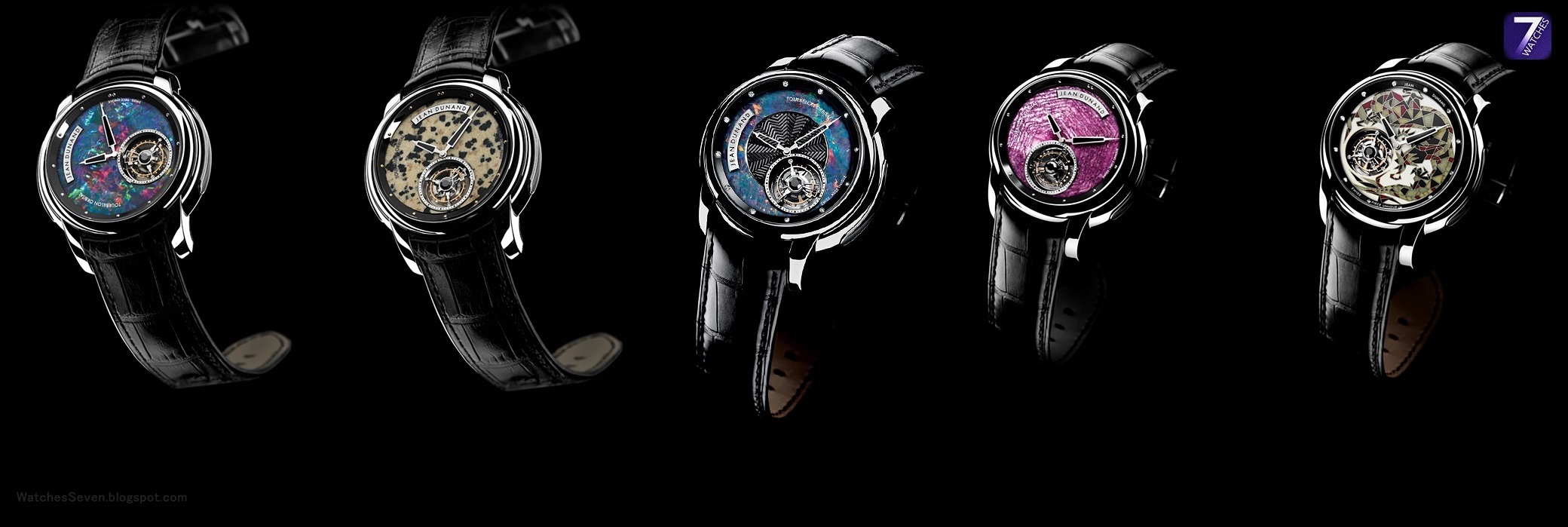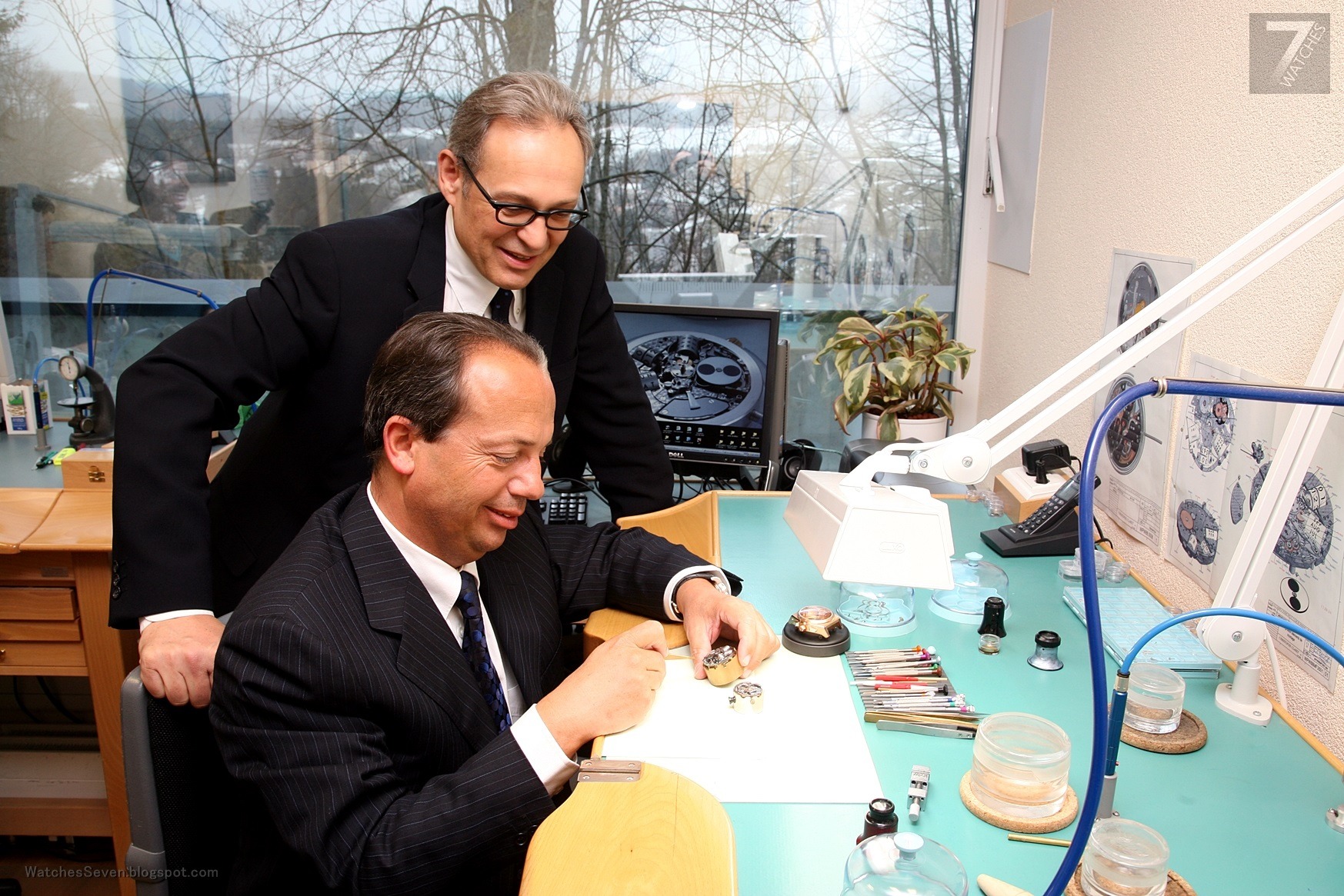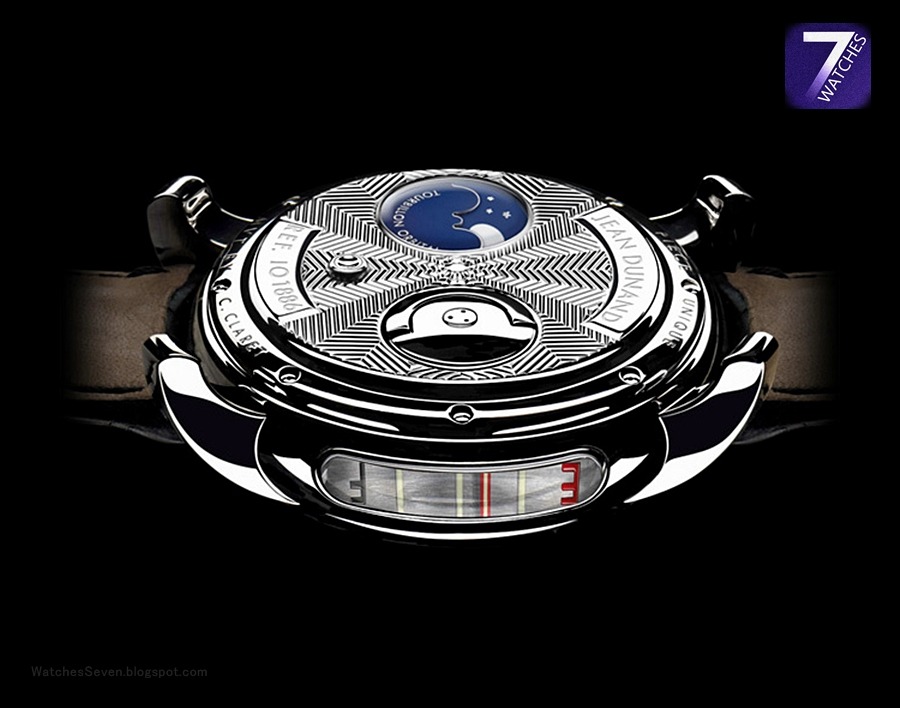JEAN DUNAND - Tourbillon Orbital
The Tourbillon Orbital features an extraordinary one-minute flying tourbillon that orbits the dial once per hour on a patented revolving movement, a novel power reserve indicator in the case band and moon phase on the caseback.
Visually sublime, the Tourbillon Orbital is a masterpiece of haute horlogerie. Timing tests indicate that the combined rotation of the tourbillon and the movement significantly improves the rate stability of the watch.
Click on the mouse wheel to see the large size ...
Here the rarest and most unexpected materials, anachronistic craftsmanship and unheard of complications find a place to flourish far from commercial pressures and the noise generated by the machines of mass luxury.
Maria Doulton Watch & Jewelry journalist
It took Christophe Claret two years to solve the challenge of winding and setting a constantly rotating movement and mainspring barrel with an innovative folding key set vertically into the movement’s central axis that both winds the mainspring and sets the time.
The absence of a crown facilitated a fascinating lateral view of the revolving mechanisms through two windows in the case band. The secret of statically indicating the power reserve of a constantly moving barrel is patented, while the dial is a revolving canvas displaying the world’s best art, craft and natural materials.
As with every Jean Dunand timepiece, each Tourbillon Orbital is a unique piece.
---------------------------------------
Click on the mouse wheel to see the large size ...
TOURBILLON ORBITAL
WHO SAID “IMPOSSIBLE”?
Launching the family of JEAN DUNAND watches, a continual pro-gram of Pièces Uniques, required something more than a mere aes-thetic fillip. The watch had to be fresh, original, groundbreaking. At a time when watch connoisseurs are spoiled for choice, a watch com-memorating the great Art Deco artist and craftsman had to be heart-stoppingly beautiful and daring.
Click on the mouse wheel to see the large size ... BIG FOTO
That honor fell to the Tourbillon Orbital, the first of JEAN DUNAND timepiece and an achievement never before seen in watchmaking. It features a one-minute flying tourbillon that orbits the dial once every hour, on a revolving movement. The watch also introduces a novel power-reserve indicator in the case-band, provides a full view of the movement and displays the phases of the moon on the case-back.
So extraordinary is this movement that it is patent-protected.
Reinstating the tourbillon as a precision device
Click on the mouse wheel to see the large size ... BIG FOTO
With every ambitious watchmaker jumping on the tourbillon “band-wagon”, it is not surprising that some enthusiasts are voicing a back-lash. Strange though this may seem, the sheer profusion of lesser tourbillons has rendered the complication almost “common”. Thierry Oulevay and Christophe Claret, however have too much respect for the concept to allow it to be devalued.
To this end, they have created the IO200 movement, named after Ju-piter’s moon. Invented and constructed by Claret, it defies the opin-ion of his fellow watchmakers who insisted that an orbiting tour-billon was impossible to realize. It is a gauntlet thrown before the most experienced houses. Furthermore, it returns the tourbillon to its original role as the pre-eminent precision complication. Timing tests prove that the combined rotation of the tourbillon and the movement significantly improves the rate stability of the watch.
Click on the mouse wheel to see the large size ... BIG FOTO
Wheels within wheels
Positioned opposite each other, sandwiched between two plates held apart by pillars and rotating on ball bearings, the barrel and the flying tourbillon orbit the center. The revolving top plate is open to reveal the tourbillon. The tourbillon has been raised as much as possible to make it more clearly visible.
Unwinding against a central fixed pinion, the barrel drives itself and the tourbillon, while the tourbillon escapement regulates the speed of rotation. As it orbits, the tourbillon cage rotates once a minute against a fixed circumference wheel, connected through a gear train. This elegant configuration reduces the number of jewel bearings to 14, substantially lowering friction.
How to wind and set a rotating movement
Click on the mouse wheel to see the large size ... BIG FOTO
Christophe Claret devoted two years to solving the mechanical chal-lenge of winding and setting a rotating movement with a mainspring barrel that never stays in one place. The conventional crown through the case-band was obviously impossible.
Winding and setting the movement vertically through its central axis is a new solution in watchmaking. A folding key set into the case-back replaces the crown. Lifting the D-ring of the key engages a central wheel on ball bearings that turns the ratchet-wheel to wind the bar-rel-spring. Pulling out the key engages the hours- and minutes-hands in order to set them in any direction. Positioned against the fixed chapter-ring, the minutes-hand turns with the rotating dial.
Click on the mouse wheel to see the large size ... BIG FOTO
Windows to the heart of the movement
Inescapably, the winding key and the moon-phase display on the back of the watch prevent a conventional view of the rotating movement through a sapphire-crystal case-back.
Conveniently, though, the absence of the usual crown at 3 o’clock allowed JEAN DUNAND’s case-makers to provide a fascinating lat-eral view of the revolving mechanisms by cutting two windows in the case-band.
Click on the mouse wheel to see the large size ...
Click on the mouse wheel to see the large size ... BIG FOTO
A power-reserve indicator never seen before
These side windows opened the opportunity for another first in watch-making – an entirely original way of indicating the power reserve. The window at 3 o’clock displays a vertical needle that moves between
F (full) and E (empty). Precisely in the manner of fuel gauges in vintage cars. The secret of indicating the power-reserve in one place from a constantly moving barrel is patented.
Click on the mouse wheel to see the large size ...
--------------------------------------------------
TECHNICAL SPECIFICATIONS
Calibre IO200 (Io from the name of one of Jupiter’s moons.)
Manually wound rotating movement with off-centre flying tourbillon,
moon-phase display and power-reserve indicator.
INDICATIONS
Central hours and minutes,
seconds on the tourbillon,
power reserve, moon phases.
Moon phase located in the caseback at 9 o’clock,
precision of 29.5 days, lacquered golden disc.
CONTROLS
Rapid push-piece in the caseback at 6 o’clock,
manual push-piece to set the moon.
TOURBILLON
One-minute flying tourbillon (one-hour movement rotation)
Balance with adjusting screws on a flat spring
21’600 a/h, central ball-bearing system
MOVEMENT FEATURES
Rotating movement with eccentric flying tourbillon on double ball-bearing,
exclusive ball-bearing system with triple rotation using one rigid plate and two mobile plates, mainspring barrel and going train [A2]rotate around the central ball-bearing system.
Dimensions: 33mm x 10.4mm (14 1/2 lignes)
Bearings: 4 ball-bearing races, 14 jewel bearings
Number of components: 215
POWER RESERVE AND WINDING
Approximately 110 hours.
Power reserve indicator located in the caseband (linear reading system with gauge).
Winding system located vertically in the caseback at 3 o’clock, two-position winder (folding key).
CASE
18k rose gold, white gold or platinum with matching buckle
Two windows in the caseband
Fir-tree engine-turned back
Dimensions: 45mm x 15.30mm
Sapphire Crystals: Non-reflecting domed sapphire crystal
Two domed sapphire crystals in the caseband, one domed sapphire crystal in the caseback
Water resistance: 3 ATM (30 metres)
DIAL AND HANDS
Dial in 18k gold. Hands ‘Skyscraper” style in 18k gold.
---------------------------------------------
Press release PDF
-------------------------------
www.facebook.com - Jean Dunand
--------------------------------------
www.JeanDunand.com












